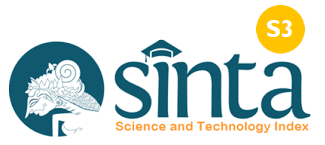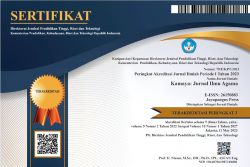Living Qur’an dalam Tradisi Batumbang di Kuburan Pada Masyarakat Desa Satiruk Kotawaringin Timur
DOI:
https://doi.org/10.37329/kamaya.v8i4.4986Keywords:
The Living Qur'an, Batumbang Tradition, Cultural Paradigm of SocietyAbstract
The practice of religious traditions and rituals in graveyards often causes controversy because some people consider them to be elements of shirk. However, these traditions remain alive, as seen in the batumbang ritual in Satiruk Village. This study aims to analyze how the Qur'an is brought to life and applied in local culture through the batumbang tradition`, as well as to understand the integration of Islamic teachings in local cultural practices. This study uses the living Qur'an theory and Emile Durkheim's Cultural Paradigm theory as its analytical framework. The method used is qualitative with a field research approach that includes observation, in-depth interviews, and document analysis. The results show that the batumbang tradition serves as an expression of the community's gratitude for the fulfillment of their vows by combining Islamic teachings, such as the recitation of Surah Al-Fatihah and Surah Yasin, with local cultural practices. In the context of Durkheim's Cultural Paradigm theory, this ritual reflects four main pillars, namely sacredness as seen in the ritual at the grave of a religious figure, role classification in the ritual, rites reflected in the recitation of Surah Yasin, and solidarity formed through togetherness in prayer and food sharing. The batumbang tradition also reflects the application of the living Qur'an, in which the teachings of the Qur'an are translated into social practices that strengthen social bonds and religious understanding among the local community. This study concludes that the batumbang tradition illustrates the synergy between Islamic teachings and local culture, which reinforce each other.
References
Aminudin, M. (2024). Nyadran dalam Tradisi Islam Kejawen: Integrasi Budaya dan Religi dalam Masyarakat Jawa. Konferensi Nasional Mahasiswa Sejarah Peradaban Islam, 1, 934–944.
Chand, S. N., Aqrandista, F. R., Asmaradana, L., Izzatullah, R. A., Firdaus, D., & Athallah, M. R. (2025). Tradisi Ziarah Kubur dalam Masyarakat Indonesia: Antara Kearifan Lokal dan Ancaman Kemurnian Tauhid. Jurnal Teologi Islam, 1(2), 127–137.
Fathoni, T. (2024). Konsep Solidaritas Sosial dalam Masyarakat Modern perspektif Émile Durkheim: The Concept of Social Solidarity in Modern Society: Émile Durkheim’s Perspective. Journal of Community Development and Disaster Management, 6(2), 129–147.
Fathoni, T., Ahrori, M. H., Wahyuni, F., & Samsudin, S. (2024). Peran teori sosial Émile Durkheim dalam pengembangan pendidikan agama Islam (perspektif solidaritas sosial dan integrasi masyarakat). AL-MIKRAJ Jurnal Studi Islam Dan Humaniora, 5(01), 1654–1668.
Fuady, V. K., & Fadillah, Y. N. (2025). Makam Eyang Ki Kebo Kenongo: Titik Temu Sejarah Lokal, Spiritualitas Jawa, Dan Arsitektur Islam Awal: Eyang Ki Kebo Kenongo Tomb: The Intersection Of Local History, Javanese Spirituality, And Early Islamic Architecture. Al-ABSAH: Jurnal Adab, Bahasa, Sastra, Dan Sejarah, 1(2), 1–14.
Hasanah, N., & Zuraidah, Z. (2019). Upacara Nadzar Batumbang Apam di Makam Keramat Gajah Desa Kubah Sentang. Jurnal Socius: Journal of Sociology Research and Education, 6(1), 42–50.
Huwaida, F. (2025). Analisis Hukum Islam Terhadap Tradisi Batumbang Apam Pada Masyarakat Banjar. Indonesian Journal of Islamic Jurisprudence, Economic and Legal Theory, 3(1), 102–109.
Khasanah, L. (2022). Akulturasi agama dan budaya lokal. AT-THARIQ: Jurnal Studi Islam Dan Budaya, 2(02), 37–49.
Komariah, K. (2023). Pengembangan Karakter Religius Masyarakat Desa Rukam melalui Aktivitas Keagamaan. AL QUWWAH: Jurnal Pengabdian Masyarakat, 3(2), 328–336.
Masykar, T., & Pikri, P. (2025). Penguatan Moderasi Beragama Melalui “Living Quranic Values” di Pesantren:(Studi Pondok Pesantren Barat Tengah Aceh). Basha’ir: Jurnal Studi Al-Qur’an Dan Tafsir, 5(1), 87–98.
Maulidah, A. N., Erawati, D., & Munirah, M. (2023). Reading Hadrah Basaudan: Study of living Qur’an at Hidayatus Salikin Boarding School Pembuang Hulu Village. Fenomena, 22(2), 183–196.
Muizzah, U. (2019). Al-Qur’an Dalam Tradisi Manganan Di Desa Soko Medalem Kecamatan Senori Kabupaten Tuban. AL ITQAN: Jurnal Studi Al-Qur’an, 5(2), 101–122.
Mustofa, A. Z. (2020). Konsep Kesakralan Masyarakat Emile Durkheim: Studi Kasus Suku Aborigin di Australia. Madani Jurnal Politik Dan Sosial Kemasyarakatan, 12(03), 265–280.
Naamy, N. (2022). Relasi agama dan budaya dalam hubungan sosial masyarakat islam di Bima. TAJDID: Jurnal Pemikiran Keislaman Dan Kemanusiaan, 6(2), 285–295.
Nihayati, D. A. (2023). Upaya Pelestarian Sejarah Ulama dan Tokoh di Ponorogo melalui Kegiatan Ziarah Makam. Jumat Keagamaan: Jurnal Pengabdian Masyarakat, 4(2), 64–71.
Ningsih, T., Arfan, K. N. F., & Masyhur, L. S. (2025). Living Qur’an: Sebuah Pendekatan Kontekstual dalam Memahami Al-Qur’an. Journal Hub for Humanities and Social Science, 2(1), 116–126.
Novayani, I. (2019). Pendekatan Studi Islam: Pendekatan Fenomenologi dalam Kajian Islam. At-Tadbir: Jurnal Manajemen Pendidikan Islam, 3(1), 44–58.
Nugeraheni, R. A., Lattu, I. Y., Suwarto, S., & Tampake, T. (2024). Nilai-Nilai Pancasila Dalam Tradisi Kenduri Sebagai Sarana Memperkuat Solidaritas Antar Umat Beragama. Visio Dei: Jurnal Teologi Kristen, 6(2), 92–103.
Rozaki, A. (2021). Islam, oligarki politik, dan perlawanan sosial. Yogyakarta: IRCiSoD.
Shiddiq, M. N. (2025). Tradisi Batumbang Apam Pada Suku Banjar Di Desa Jatuh Hulu Sungai Tengah. Indonesian Journal of Islamic Jurisprudence, Economic and Legal Theory, 3(1), 193–201.
Sunarto, K. (2005). Pengantar sosiologi. Jakarta: Pada Lembaga Penerbit Fakultas Ekonomi Universitas Indonesia.
Downloads
Published
How to Cite
Issue
Section
License
Copyright (c) 2025 Kamaya: Jurnal Ilmu Agama

This work is licensed under a Creative Commons Attribution-ShareAlike 4.0 International License.
An author who publishes in the Kamaya : Jurnal Ilmu Agama agrees to the following terms:
- Author retains the copyright and grants the journal the right of first publication of the work simultaneously licensed under the Creative Commons Attribution-ShareAlike 4.0 License that allows others to share the work with an acknowledgement of the work's authorship and initial publication in this journal
- Author is able to enter into separate, additional contractual arrangements for the non-exclusive distribution of the journal's published version of the work (e.g., post it to an institutional repository or publish it in a book) with the acknowledgement of its initial publication in this journal.
- Author is permitted and encouraged to post his/her work online (e.g., in institutional repositories or on their website) prior to and during the submission process, as it can lead to productive exchanges, as well as earlier and greater citation of the published work (See The Effect of Open Access).
Read more about the Creative Commons Attribution-ShareAlike 4.0 Licence here: https://creativecommons.org/licenses/by-sa/4.0/.





